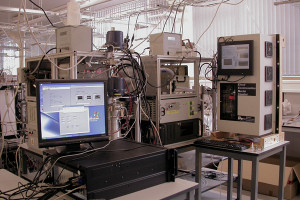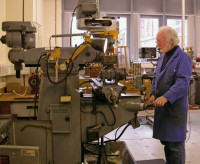General Labs
In addition to the various chamber facilities, the Centre for Atmospheric Science laboratories within the Simon Engineering Building include a generous allocation of high quality well equipped general laboratory space. All lab areas are fitted out with chemical resistant benches and cupboards, mobile tables, wall and overhead power and data sockets and most also have air conditioning, compressed air, vacuum and other centrally supplied gas points. The larger labs are also equipped with fume extraction hoods, and several areas are equipped as dark rooms or laser safety rooms. A large field equipment storage area, two workshops, a library/meeting room, a tea area and a small server room also form part of the facility. Staff and student offices are located in and around the main laboratory facilities. In all the centre's laboratory and office facilities occupy one wing of the Simon Engineering Building from the basement up to the third floor, with a few overflow offices located on the fourth floor.
The aerosol and trace gas laboratory
The aerosol and trace gas lab is home to the majority of the centre's aerosol and trace gas instrumentation, including aerosol mass spectrometers, chemical ionisation mass spectrometers, quantum cascade laser adsorption systems, differential mobility particle sizers, hygroscopic tandem differential mobility analysers, cloud condensation nucleus counters and trace gas monitoring instruments. Work undertaken in this lab includes laboratory measurement programs sampling from the aerosol chamber directly below, from a bubble tank to study mechanical production of aerosol from the sea surface, and from external air via the labs aerosol inlet lines. The lab is also used extensively for instrument calibration and development and hosts a comprehensive suite of aerosol generation and calibration devices able to generate particles with know characteristics over most of the size range which our instruments can measure.
Cloud microphysics laboratories
The cloud physics facilities in addition to the main cloud chamber and associated labs consist of three separate areas, one a general use laboratory which is also equipped with several freezers allowing experiments and testing to be conducted down to temperatures as low as -80°C, one equipped as a wet area for testing cloud droplet probes etc., and one as a laser safety area. Current laboratory work includes the development and testing of an ice nucleus chamber, the airborne droplet analyser, and maintenance and calibration of the suite of aircraft and ground based cloud microphysics probes.
Lidar laboratories
Consisting of two adjacent areas, both of which can be operated as dark rooms and one which is fully equipped for laser safety and lidar operation. This room is fitted with a roof hatch allowing remote sensing measurements to be made directly from the laboratory. The hatch is fitted with an automatic closure system which closes the hatch and shuts off the laser when rain is detected.
UV laboratories
Consisting of two adjacent areas, one of which is a black room. These are used for the development and testing of equipment used for monitoring UV transmission through the atmosphere.
The UV laboratory houses a number of instruments for measuring radiation, and the facilities for instrument calibration and characterisation, plus solar simulation. The radiation instruments may be used in the laboratory, in the field, or airborne, depending on requirement.
Bentham DTM300. double monochromator scanning spectroradiometer. Temperature stabilised, FWHM = 0.65 nm. Two entrance slits enable two input optics via quartz fibre light guides, but channels must be scanned sequentially. Input optics determine parameter: irradiance, actinic flux (spherical irradiance, fluence rate), direct beam radiation, radiance distribution. The latter two quantities use a custom built suntracker with a 1 degree field of view. Emphasis is on solar UV measurements, normal scan range 280 to 500 nm at 0.5 nm intervals. Laboratory or field use.
Optronics 742. double monochromator scanning spectroradiometer. Temperature stabilised, FWHM = 1.5 nm. Measures irradiance, typically 280 to 500 nm. Forerunner to Bentham. Now used predominantly in the laboratory, but has been used in the field and aircraft. Single entrance slit, but can be fitted with bifurcated fibre for rapid sampling of two different inputs in turn (principally used on the aircraft). Input optics are cosine response for irradiance.
Metcon photodiode array. A two channel diode array (single monochromator) instrument giving almost instantaneous spectral sampling. FWHM = 2.5 nm, spectral range 280 to 700 nm. Input optics are 2 pi actinic flux, used together to give 4 pi actinic flux, or one channel can be fitted with narrow field of view optic for direct beam and radiance distribution measurements using the sun tracker. Laboratory, field or aircraft use (fits in 19 inch rack). Solar UVB measurements may be affected by stray light and detection limits - requires careful data handling for this application.
Ocean Optics S2000. Dual, single monochromator, diode array spectroradiometers giving almost instantaneous spectral sampling. Wavelength range 200 to 850 nm, FWHM = 1.3 nm. Measures irradiance. Some problems with solar UVB due to straylight and detection limits. Very small and intended for aircraft use, but also available in laboratory and field.
Solar simulator. Oriel system with 1000W xenon lamp (ozone free). May be fitted with a variety of filters or a monochromator to determine spectral output. Horizontal or vertical beam available, or fibre optic light guide.
Laboratory calibrations are based on NIST standards of spectral irradiance (FEL, 1000W tungsten halogen). Instruments may be calibrated directly against these lamps, or the standard transferred to 200W DXW lamps for calibration in the field.
Facilities also exist for wavelength calibration of spectroradiometers, angular response tests for input optics and spectral response tests for broadband instruments.
Workshops
The main workshop is fully equipped as a mechanical workshop with a range of machinery including saws, lathes, drills, milling machines, etc. It is staffed by three technicians and provides services to the whole of the School of Earth, Atmospheric and Environmental Sciences. The second workshop is available for general use for instrument construction, and field preparation. It is equipped with a small lathe, milling machine and pillar drill as well as a range of hand tools.

